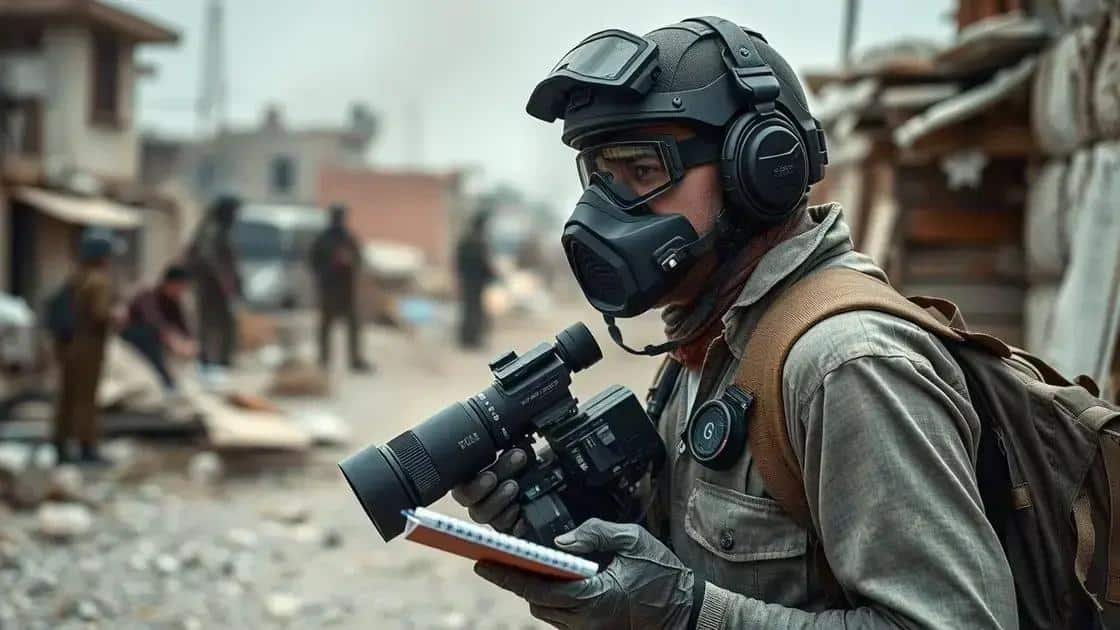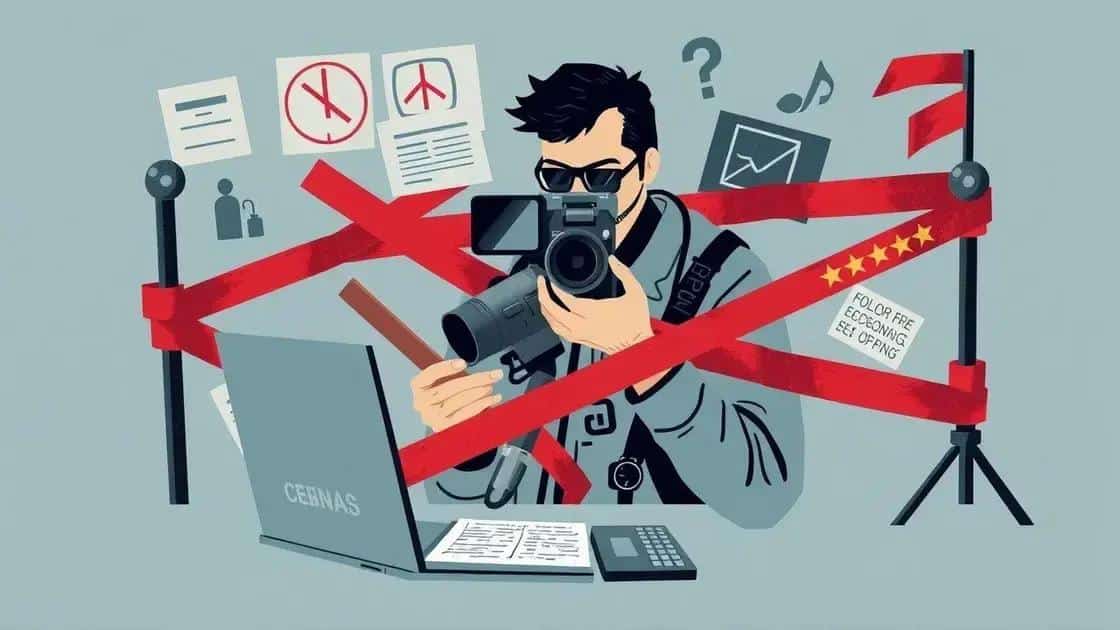Press freedom violations worldwide: Understanding the impact

Press freedom violations worldwide pose significant threats to journalists, who face violence, censorship, and legal challenges, highlighting the urgent need for protection and advocacy to ensure their safety and continued access to information.
Press freedom violations worldwide are a pressing concern for democracy and truth. Have you ever wondered what happens to those who dare to speak out? This article delves into the challenges faced by journalists and the importance of safeguarding their rights.
Current state of press freedom globally
The current state of press freedom globally is a mixed picture. In many parts of the world, journalists face serious risks while trying to report the truth. This situation raises important questions about how free the press really is today.
Across various countries, some governments impose severe restrictions on media outlets. These restrictions can range from strict censorship laws to outright violence against journalists. For instance, in countries with authoritarian regimes, the government often controls the narrative, limiting the information available to the public.
Regions with Significant Challenges
Several regions are particularly known for their challenges to press freedom. Here are a few:
- Middle East: Countries like Syria and Sudan face extreme media oppression.
- North Korea: Complete state control leads to a total lack of press freedoms.
- Eritrea: It ranks as one of the most repressive countries for journalists.
- China: The government strictly controls media reports, stifling dissent.
In contrast, some nations enjoy high levels of press freedom. Countries like Finland and Norway lead the way, offering a safe environment for journalists to operate and ensuring that the public has access to a diverse range of perspectives. These differences illustrate a global divide in how press freedom is valued and protected.
Moreover, international organizations often monitor and report on press freedom violations. Groups such as Reporters Without Borders and the Committee to Protect Journalists raise awareness about these issues, providing crucial data that can influence global discourse. Their reports highlight the necessity for vigilance in protecting journalists and amplifying the fight for media rights.
The increasing involvement of technology in news reporting also plays a role in shaping the current state of press freedom. While it can help spread information quickly, it also poses new challenges. For example, social media platforms can sometimes become tools of censorship or misinformation, complicating the landscape even further.
As we consider the current state of press freedom globally, it becomes clear that while pressures persist, there are also many advocates and organizations striving for improvement. Ongoing efforts to support journalists and safeguard their rights are vital for a healthy democracy and an informed public.
Major violations reported in recent years
In recent years, several major violations of press freedom have been reported across the globe. Journalists face increasing hostility, ranging from intimidation to outright violence as they strive to uncover and report the truth. These violations highlight the urgent need for global awareness and action.
Many countries have seen chilling examples of journalists being attacked or imprisoned simply for doing their job. For instance, in **Turkey**, numerous reporters have been imprisoned under anti-terror laws, showcasing how governments can misuse legislation to silence dissenting voices.
Key Examples of Violations
Various examples illustrate the severity of the situation:
- Mexico: A significant number of journalists have been murdered, often in connection with drug cartels.
- Saudi Arabia: The assassination of journalist Jamal Khashoggi drew international outrage and highlighted the dangers of reporting in oppressive regimes.
- Russia: Independent media faces severe crackdowns; many journalists have faced threats or been forced into exile.
- Belarus: The government has violently suppressed protests, leading to arrests of many journalists covering these events.
In addition to physical threats, there are also legal assaults on press freedom. Governments may impose heavy fines, legal restrictions, or emergency laws that curtail freedom of speech. In countries like **Hungary**, the media landscape has shifted dramatically, with significant government control over public broadcasting. Journalists in these environments find it increasingly difficult to report freely and objectively.
Furthermore, online harassment has become an integral part of the challenges faced by journalists. Many reporters receive threats through social media platforms, making it hard to operate without fear. This kind of intimidation not only affects individual journalists but also discourages broader journalistic efforts as fear of repercussions looms large.
As these challenges to press freedom continue to grow, organizations and activists advocate for the protection of journalists. This includes calling on governments to uphold their obligations to protect the media from threats. International allyship and awareness make a significant difference in enhancing safety and maintaining the integrity of journalism.
Impact of censorship on journalism

The impact of censorship on journalism is profound and far-reaching. Censorship limits what journalists can say and report, creating an environment where truth can become distorted or hidden. This poses significant challenges for media outlets aiming to provide honest coverage.
When censorship occurs, it often silences voices that report on critical issues. In countries with strict media regulations, journalists face the constant threat of arrest or punishment for covering topics deemed sensitive by the government. This leads to a culture of fear, where many reporters avoid investigating important stories.
Consequences of Censorship
Censorship can lead to several critical consequences for journalism:
- Loss of Trust: When the media is not free, public trust in journalism can erode. People may become skeptical about news sources, believing that what they hear is manipulated.
- Limited Diversity: Censorship often restricts the variety of perspectives that can be presented. This lack of diversity can result in a narrow narrative that fails to capture the realities of society.
- Stifling Innovation: New ideas and reporting techniques can be suppressed under censorship. Media companies may hesitate to explore creative methods of storytelling if they fear repercussions.
- Informed Citizens: Without a free press, citizens lack the vital information needed to make informed decisions. This can result in disengagement from important social and political issues.
Censorship doesn’t only affect information published in traditional formats; it also extends to digital media. Online content can face heavy restrictions and removals, affecting how journalists use technology to communicate with the public. Social media companies are often caught in the crossfire, as they try to balance free expression with local laws mandated by governments.
Moreover, the psychological toll on journalists who face censorship can be severe. Many report experiencing anxiety and stress while navigating a dangerous work environment. This not only hinders their productivity but can also lead to burnout, hampering their ability to deliver news effectively.
Despite these challenges, many journalists continue to advocate for press freedom and fight against censorship. They seek to uncover the truth, relying on international support and solidarity from their peers. Global campaigns and organizations actively work to highlight the importance of free expression, pressuring governments to uphold their commitments to protect journalists and independent media.
Role of technology in shaping press freedom
The role of technology in shaping press freedom is increasingly significant in our modern world. Technology has transformed how news is reported, distributed, and consumed. It plays a dual role, offering both opportunities and challenges for journalists.
With the rise of digital platforms, journalists can reach audiences far beyond traditional print and broadcast media. Social media, blogs, and streaming services allow reporters to share their stories in real time. This accessibility can enhance transparency, as more voices are amplified. However, the same platforms can serve to spread misinformation, complicating the landscape of reliable news.
Positive Impacts of Technology
Technology has several positive impacts on press freedom:
- Instant Communication: Journalists can share breaking news quickly, keeping the public informed.
- Wide Reach: Stories can go viral, reaching global audiences and raising awareness about important issues.
- Citizen Journalism: With smartphones, everyday people can report events, providing firsthand accounts that complement traditional news sources.
- Access to Information: Journalists now have tools to access and analyze data, making investigative reporting more thorough and impactful.
Despite these advantages, there are significant challenges linked to technology. Governments may use advanced surveillance tools to monitor journalists and control information flow. This increased scrutiny can lead to cautious reporting, where journalists may avoid sensitive topics to ensure their safety.
Additionally, media companies face financial pressures from the digital environment. Many traditional outlets struggle to generate revenue as advertising shifts online. This can lead to cutbacks in investigative journalism, which is vital for holding powers accountable. The result is a less informed public and decreased trust in media institutions.
The Balance of Power
In this technology-driven age, it is essential for journalists and media organizations to adapt to the changing landscape. Training in digital literacy and understanding data privacy is crucial for today’s reporters. They must navigate the complexities of technology while maintaining ethical standards.
Furthermore, advocacy for digital rights is more important than ever. Organizations that support press freedom must address the challenges posed by technology and work to ensure that journalists can operate freely and safely online.
While technology shapes the future of journalism, it also highlights the ongoing struggle for press freedom. By recognizing both the strengths and weaknesses of technological advancements, societies can work toward a more informed and equitable future for news reporting.
What can be done to protect journalists
Protecting journalists is crucial for a healthy democracy and a well-informed public. There are several steps that can be taken to ensure their safety and freedom to report. Advocacy and awareness are important tools in this fight against press freedom violations.
Governments play a key role in protecting journalists. They should introduce and enforce laws that ensure safe working conditions for reporters. This means addressing threats and violence against journalists, prosecuting those responsible for attacks, and removing barriers to independent reporting. Strong legal protections can help create an environment where journalists can work without fear.
Support Organizations
Numerous organizations work tirelessly to support journalists around the world. Some of these include:
- Reporters Without Borders: This global organization defends journalists and promotes freedom of information.
- The Committee to Protect Journalists: They work to provide assistance and uphold the rights of journalists through advocacy.
- International Federation of Journalists: They support and promote the interests of journalists at both local and international levels.
- Article 19: This organization defends the rights to freedom of expression and information.
These organizations often provide resources, training, and legal assistance to journalists under threat. They also raise global awareness of the issues journalists face, pushing for changes that lead to safer environments for reporting.
Moreover, the public can play a role by supporting independent media. By subscribing to reputable news outlets and sharing accurate information, individuals can help counter misinformation and strengthen journalism. Public support can encourage media organizations to maintain their commitment to quality reporting.
Digital Security Training
Another important aspect of protecting journalists is providing digital security training. Many reporters face threats not only from physical violence but also from cyber attacks. Training in data protection, secure communication, and anonymity can empower journalists to protect themselves and their sources effectively.
Finally, international pressure is vital. When governments or entities violate press freedom, countries and international organizations must hold them accountable. Diplomatic efforts should aim to recognize and address abuses against journalists. Global solidarity can bring attention to press freedom issues and promote necessary changes.
FAQ – Questions about protecting journalists and press freedom
Why is it important to protect journalists?
Protecting journalists is vital for ensuring a free society and a well-informed public, as they provide critical information and hold those in power accountable.
What can organizations do to support journalists?
Organizations can provide resources, training, and legal assistance to journalists facing threats. They also advocate for press freedom and raise awareness of violations.
How can the public help promote press freedom?
The public can support independent media by subscribing to reputable news sources and sharing accurate information, helping to counter misinformation.
What are some tools for ensuring journalist safety?
Digital security training is essential, along with tools for secure communication and data protection, to help journalists protect themselves and their sources.





